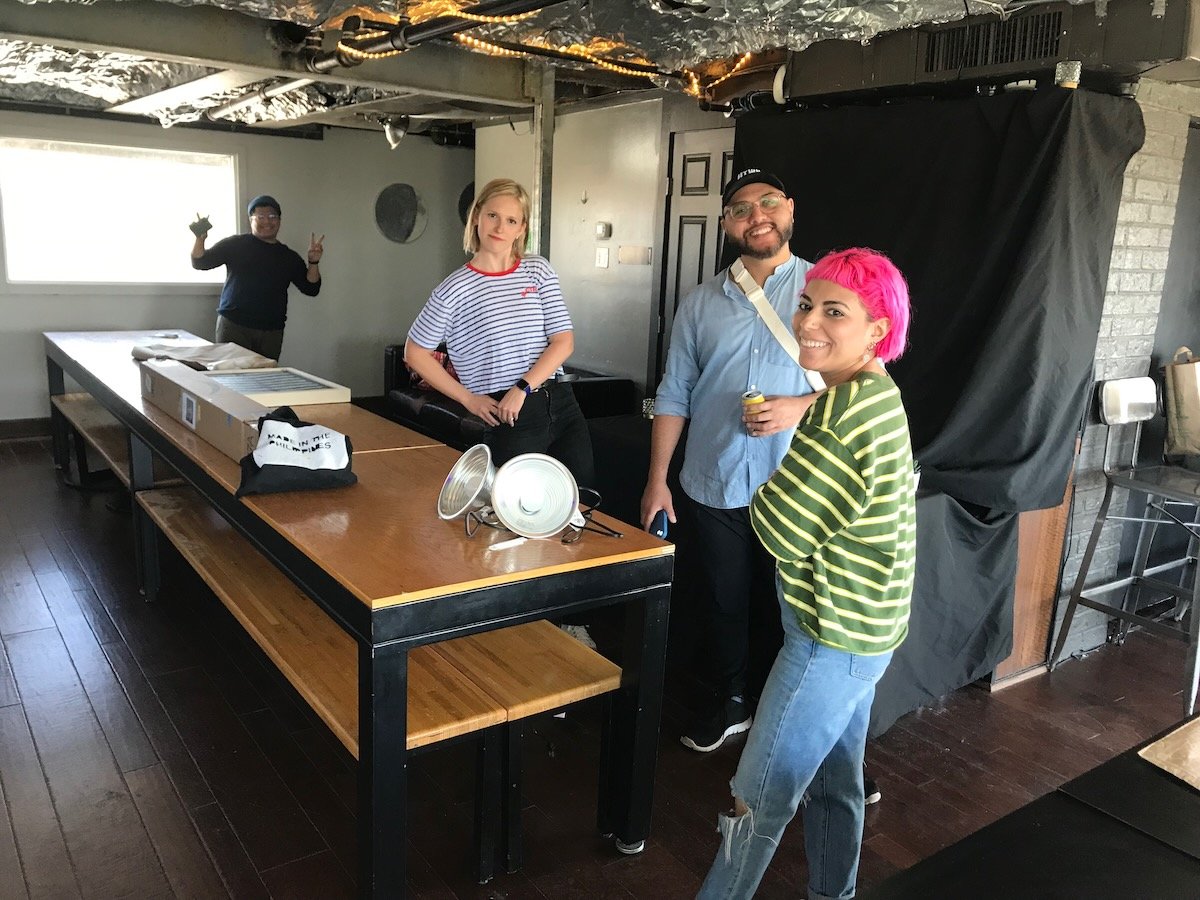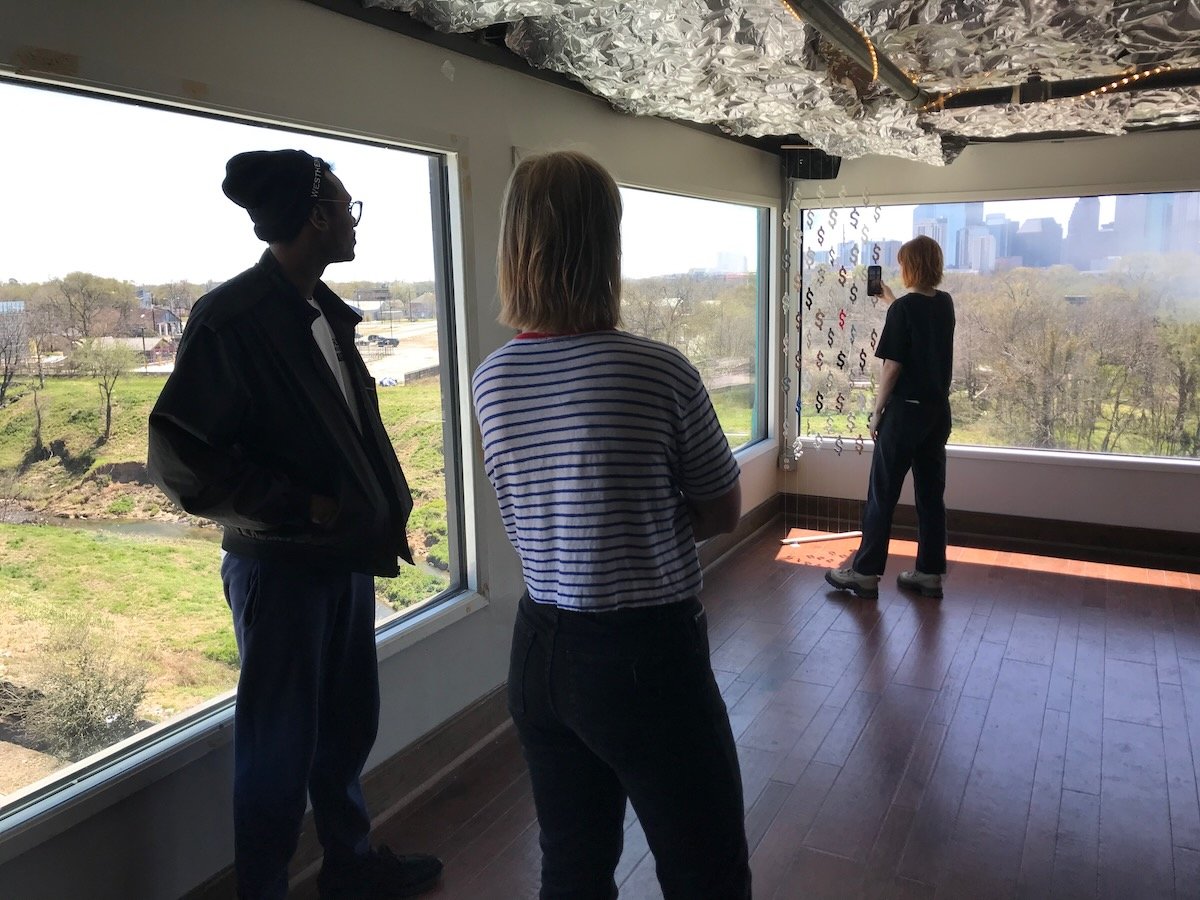I joined the artist collective Open MFA in fall 2019. We–Amanda, Hillaree, Ryan, and I–hosted social events, organized artist talks, and planned a collaborative group show for 2020. Then the pandemic hit. We tried planning a few virtual events, but those quietly subsided as Zoom burn out took over. Open MFA went on a hiatus.
In January 2022, nearly two years later, Open MFA relaunched. We planned our first meet-up for February and brainstormed ideas for the new year. By March, we hosted our first group show at Raven Tower.
It was a collaborative effort to say the least. Ryan secured the venue, and the rest of us jumped on board. We enlisted Megan Olivia Ebel for curation. She was excited to use the alternative art space to make a unique show overlooking downtown Houston. We sent her work by the Open MFA community, and she planned the installation.
Exhibiting artists Matt Manalo, myself, Hugo Pérez, and Cynthia Giron preparing the space.
The actual installation of the show was the event’s primary challenge. Clean-up, moving furniture, and art installation had to be done day-of. This challenge, however, turned into an opportunity for witnessing an incredible community working together. All of the Open MFA artists worked collectively to prepare the space. By noon, the show was ready. I was reminded of why the (unpaid) work up to this point was worth it and how Open MFA facilitates community.
Amanda broadcasted the walkthrough while the curator Megan Olivia Ebel talked about the work.
Work by Cynthia Giron (left) and myself (right) discussed by Megan Olivia Ebel on Instagram.
At 1PM, we hosted a walkthrough with the curator. Megan talked about each of the works and the overall premise of the show. Due to the show being a one-day event, the exhibition needed an online means of sharing and documentation. The walkthrough is available on the Open MFA Instagram (skip over the first minute of two of silence).
Curatorial Statement
Megan Olivia Ebel’s curatorial statement was included in the exhibition zine designed by Amanda Powers.
When Open MFA—a collective of emerging Houston artists established as a resource for continuing art education and expanding individual art practices—approached me to collaborate with their community via curation of their Raven Tower Pop Up Exhibition, the opportunity to activate an environment that has held great personal significance during my tenure in Houston played a big role in the selection of works for the program. With one of the most iconic views of our incredible city: what does one celebrate, and what does one mourn when looking through the nearly 180’ vantage point of the tower?
When one enters the tower, the Houston skyline—sometimes gleaming gold from the evening sun, sometimes I-10 pathways highlighted with red and white brake light streamers, commuters leaving their work-week posts to their homes outside of the city—is no doubt the most prominent icon, and rightfully so. It is, in my opinion, uninspired to curate a show around the theme of Houston, but using the skyline as an object posits that Houston is a creation of the humans who work this city.
Non-Houstonian’s oft remark on the uselessness of our downtown, the stress of the inbound traffic, the disorganization of no zoning and lack of continuous public transportation, how our tunnel system connecting businesses are commercialized mole-ways and ridiculous in a city that is ruled by the ancient floodplains we inhabit, and how giant concrete, glass, and steel obelisks of Houston’s maternal Oil and Gas industry overpower any small green space. Until I lived Downtown, the heart of Houston, and at the intersection of Texas and Main no less, I may have agreed. Three years ago, before pandemic times, I stood looking out on the city having activated the Raven Tower for the celebration of another ending—a sale of a company—feeling some sort of ownership or pride over “my city”. I was not born here, but what does it take to feel belonging, to claim a place for yourself?
Reflecting on the artists and works selected for the Raven Tower pop up, the viewer is pushed through a lifecycle of accepting Houston—reflecting on the culture of the city, our bodies that work hard to create and manipulate our landscape and the recategorization of what our skyline stands for, the pains of expansion and gentrification, yet the celebrations of new frontiers and access that cities of similar size and capacity cannot harness.
As one enters the Raven Tower, the proverbial nest of the exhibit, we recall the rawness and rebirth of our new view—the skyline from a rarely accessed vantage point—via Mayra Huerta’s intricately veined triptych of veined manus and fleshy globules. The softness of this rebirth, through watercolor, through the delicacy of works on paper, structures the journey we are lead through as we follow the room, and traverse along the framed highway-scape. Hillaree Hamblin’s Purple Frost—a frothy lilac enzymatic composition—pushes us towards similarly alchemical works by Lorena Mitchell (Fancy) and KN0WME (Tiamat), representing a goddess familiar of a metropolitan Hathor—of fertility and love—and Tiamat—the Meso goddess of the sea, chaos, floods. When one looks out the windows of Raven Tower, a tributary of the bayou, veiled with litter, debris from some recent rainstorm, separates the building from the roadway. Similarly, Amanda Powers’ metamorphosed installation of $2/hour, separate us from the field beyond our nest, transmuting a perhaps innocent outlook on our rebirth journey, through discussion of labor and wage disparity, its connection to a city center where financial, political and social decisions are made, often without an earnest outlook of equitability for the majority of waged-workers in our affluent city. Ryan Holloway (Porto) and Jean Sebastian (October 18), lend petite portals that disrupt our view and draw attention from the living city in front to documentation of other windows not so inherent. Aliyah Montazeri and Matt Manalo’s commentary on the adornment and shaming of the tegument we choose and the husk—our skin color—we are born of. The segmentation of these categories and judgements reflect in works There, Not There (Erica Reed Lee) and The Green Room (Cynthia Giron) before entering the heel of the space, a hallway connection between end and rebirth, where lies Hugo Perez’s Terlingua 1 & 2 series and Alexandra Constantinou’s Moon Tree series, delicate embroidery on silk which reference change, connection to nature, moonscape and resonation between something we may all experience—light pollution aside.
Megan Olivia Ebel
Open MFA exhibiting artists (from left): Hillaree Hamblin, Erica Reed Lee, Ryan Hollaway, Cynthia Giron, Amanda Powers, Lorena Mitchell, Alexandra Constantinou, Jean Sebastian, and Matt Manalo.




